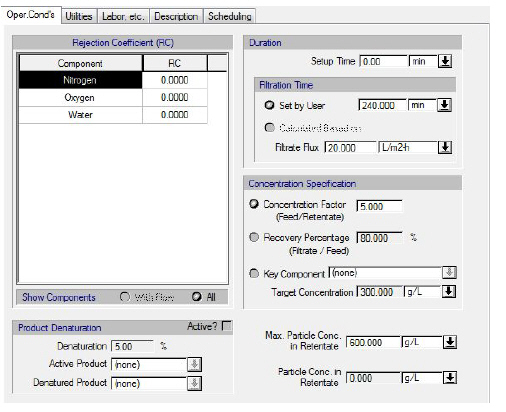

The following table shows a brief description of the variables appearing in this tab. The table also displays their default values and their generally acceptable range:
|
Variable |
Default Value |
Range |
|
|
||
|
○ Rejection Coefficient (RC) (%) |
0.0 |
0-100 |
|
○ Denaturation (%) |
5.0 |
0-100 |
|
○ Active Product |
<none> |
Any Pure Component |
|
○ Denatured Product |
<none> |
Any Pure Component |
|
○ Setup Time |
0.0 |
Positive |
|
◙ Filtration Time (min) |
240.0 |
Positive |
|
○ Filtrate Flux (L/m2-h) |
20.0 |
Positive |
|
◙ Concentration Factor |
5.0 |
Positive |
|
◙ Recovery (%) |
80.0 |
0-100 |
|
◙ Target Concentration (g/L) |
300.0 |
Positive |
|
○ Max Particle Conc. in Retentate (g/L) |
600.0 |
Positive |
Symbol Key: ○ User-specified value (always input); ● Calculated value (always output); ◙ Sometimes input, sometimes output
The following list describes the available specification choices in this tab; for more details on how these are implemented, see Batch Concentration: Modeling Calculations.
•Filtration Time Options ...
In Rating Mode (specified equipment size), the user has the option of setting either the Filtration Time or the Average Filtrate Flux.
•Product Denaturation...
Product denaturation during membrane filtration is common in bioprocessing. To account for product denaturation, the user must specify the active and denatured forms (must be different components) of the product as well as the denaturation percentage.
•Concentration Specification...
The concentration factor and recovery percentage are two equivalent ways of specifying the extent of filtration (concentration). Concentration Factor is common in bio- and food processing while Recovery is common in water purification applications where the focus is on the amount of water that goes through the membrane. The user has also got the option to specify the desired concentration of a key component at the end of the operation.